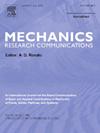基于断裂相场法的单桩基础疲劳裂纹扩展预测
IF 2.3
4区 工程技术
Q3 MECHANICS
引用次数: 0
摘要
提出了一种基于断裂相场的单桩基础疲劳裂纹扩展预测方法,研究了单桩基础表面裂纹和预埋裂纹的扩展特性。表面裂纹和嵌入裂纹均通过相场变量控制的扩散裂纹表示来建模。采用基于能量的正则化方法,将弹性应变能和断裂表面能结合起来,使总能量最小化来驱动裂纹的演化。通过求解力学-相场耦合方程来模拟无预定路径的裂纹萌生和扩展,并采用拉压能量分解来避免非物理裂纹闭合。采用跳周算法绕过线弹性阶段,加速高周疲劳模拟。建立了三维局部模型来分析由全局单桩分析得到的应力幅值下的裂纹相互作用。系统地研究了表面裂纹、嵌入裂纹及其共面结构(具有不同的厚度和长度方向间距)。研究结果表明:表面裂纹扩展速率随裂纹深长比的增大而增大,而嵌入裂纹扩展速率受深度增量的支配;厚度方向的共面裂纹相互作用随着间距的减小而加速扩展,而长度方向分离的增加改变了裂纹路径并延迟了裂纹合并。本文章由计算机程序翻译,如有差异,请以英文原文为准。
Fracture phase-field method based prediction of fatigue crack propagation at a Monopile foundation
A fracture phase-field method based prediction of fatigue crack propagation at a monopile foundation is presented, in which the propagation behavior of surface and embedded cracks at a monopile foundation is investigated. Both surface cracks and embedded cracks are modeled through a diffusive crack representation governed by phase-field variables. Energy-based regularization is employed, where crack evolution is driven by the minimization of total energy, combining elastic strain energy and fracture surface energy. The coupled mechanical-phase field equations are solved to simulate crack initiation and growth without predefined paths, and tensile-compressive energy decomposition is applied to avoid unphysical crack closure. A cycle-jump algorithm is integrated to bypass linear elastic phases and accelerate high-cycle fatigue simulations. Three-dimensional local models are established to analyze crack interactions under stress amplitudes derived from global monopile analysis. Surface cracks, embedded cracks, and their coplanar configurations (with varying thickness- and length-direction spacing) are systematically investigated. Key findings show that surface crack growth rates increase with larger crack depth-to-length ratios, while embedded crack growth is dominated by depth increments. Coplanar crack interactions in the thickness direction accelerate propagation as spacing decreases, whereas increased length-direction separation alters crack paths and delays coalescence.
求助全文
通过发布文献求助,成功后即可免费获取论文全文。
去求助
来源期刊
CiteScore
4.10
自引率
4.20%
发文量
114
审稿时长
9 months
期刊介绍:
Mechanics Research Communications publishes, as rapidly as possible, peer-reviewed manuscripts of high standards but restricted length. It aims to provide:
• a fast means of communication
• an exchange of ideas among workers in mechanics
• an effective method of bringing new results quickly to the public
• an informal vehicle for the discussion
• of ideas that may still be in the formative stages
The field of Mechanics will be understood to encompass the behavior of continua, fluids, solids, particles and their mixtures. Submissions must contain a strong, novel contribution to the field of mechanics, and ideally should be focused on current issues in the field involving theoretical, experimental and/or applied research, preferably within the broad expertise encompassed by the Board of Associate Editors. Deviations from these areas should be discussed in advance with the Editor-in-Chief.

 求助内容:
求助内容: 应助结果提醒方式:
应助结果提醒方式:


